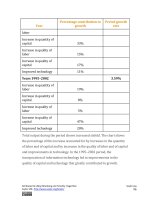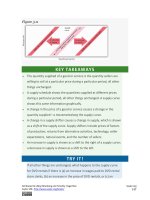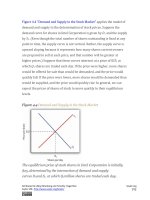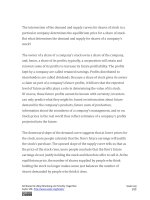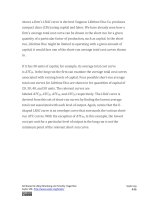Authors libby rittenberg 731
Bạn đang xem bản rút gọn của tài liệu. Xem và tải ngay bản đầy đủ của tài liệu tại đây (387.72 KB, 1 trang )
Percent Interest
49
18
2
9
06
11
42
75
92
75
20
16.3 13.5 11.4 9.81 8.5
51
90
70
8
14
7.4
69
6.6
23
5.9
29
5.3
53
4.8
70
25
19.5 15.6 12.7 10.6 9.0
23
22
83
75
77
7.8
43
6.8
73
6.0
97
5.4
67
4.9
48
30
22.3 17.2 13.7 11.2 9.4
96
92
65
58
27
8.0
55
7.0
03
6.1
77
5.5
17
4.9
79
40
27.3 19.7 15.0 11.9 9.7
55
93
46
25
79
8.2
44
7.1
05
6.2
33
5.5
48
4.9
97
50
31.4 21.4 15.7 12.2 9.9
24
82
62
33
15
8.3
04
7.1
33
6.2
46
5.5
54
4.9
99
1. Your Uncle Arthur, not to be outdone by Aunt Carmen, offers you a
choice. You can have $10,000 now or $30,000 in 15 years. If you took
the payment now, you could put it in a bond fund or bank account
earning 8% interest. Use present value analysis to determine which
alternative is better.
2. Remember Carol Stein’s tractor? We saw that at an interest rate of
7%, a decision to purchase the tractor would pay off; its net present
value is positive. Suppose the tractor is still expected to yield $20,000
in net revenue per year for each of the next 5 years and to sell at the
end of 5 years for $22,000; and the purchase price of the tractor still
equals $95,000. Use Tables (a) and (b) to compute the net present
value of the tractor at an interest rate of 8%.
3. Mark Jones is thinking about going to college. If he goes, he will
earn nothing for the next four years and, in addition, will have to
pay tuition and fees totaling $10,000 per year. He also would not
Attributed to Libby Rittenberg and Timothy Tregarthen
Saylor URL: />
Saylor.org
731
